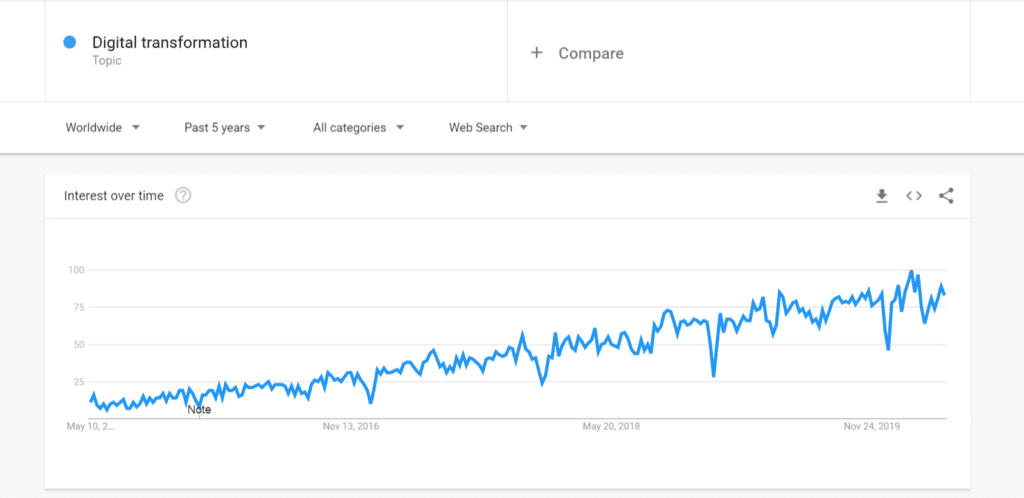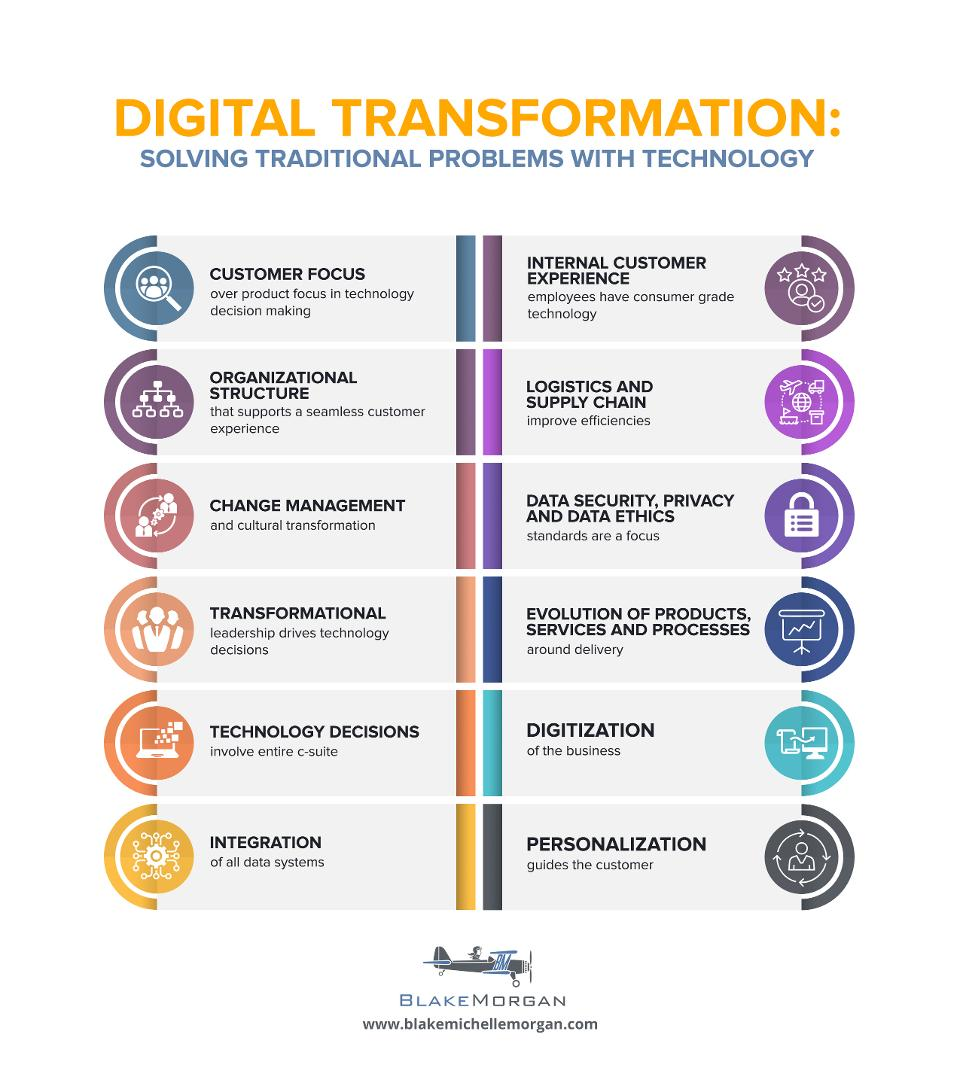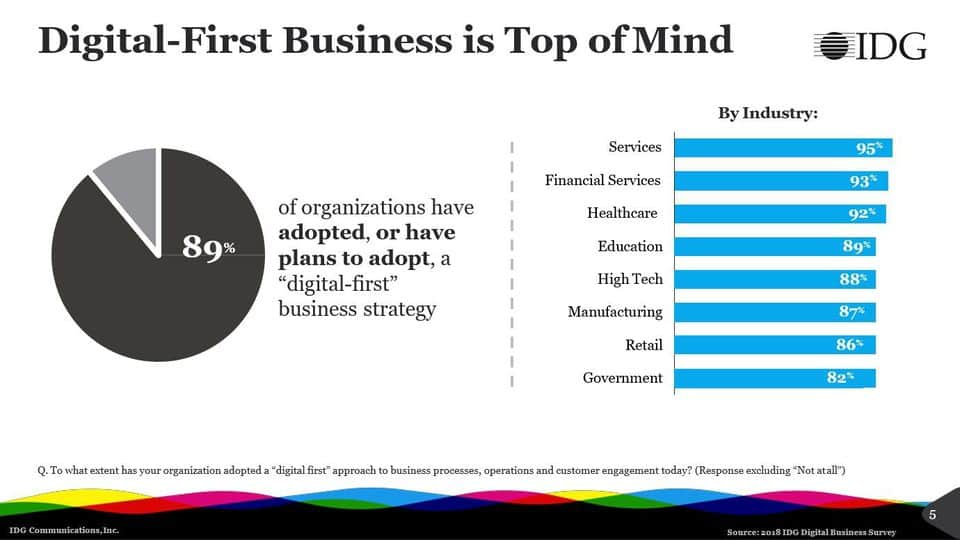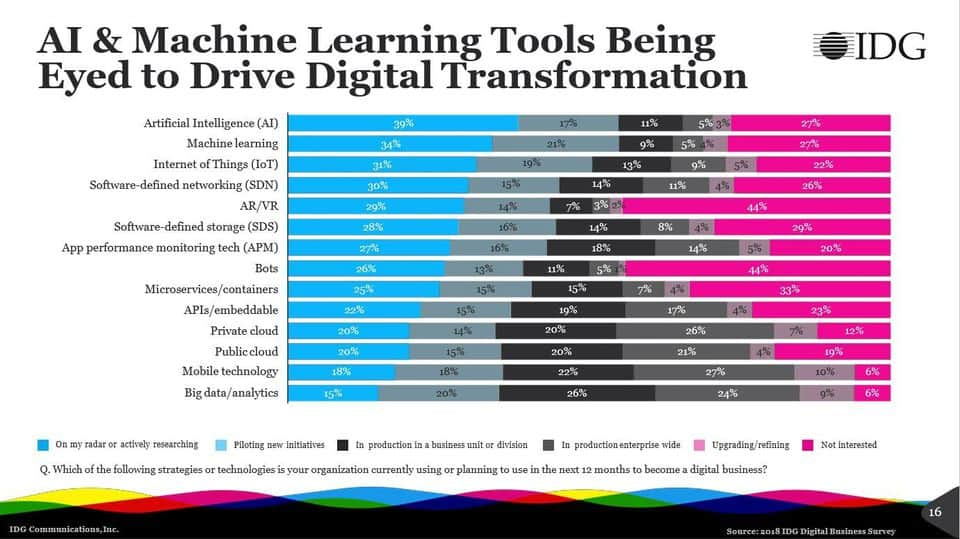Digital transformation (also known as “DX”) is not just a buzzword. As reported by Gartner, the pace of digital transformation is accelerating. It’s estimated that 75% of organizations worldwide will have undergone significant digital transformation initiatives by now to enhance their business operations and remain competitive.
The term is not entirely new. It has been around since the 1990s when email and the internet came out as ubiquitous tools for businesses. Since 2013, it has been gaining popularity and has become an actual part of many business plans.

Digital transformation has the potential to transform any area of business. In the finance department, machine learning can automate invoicing. For marketers, cloud computing will influence how files are transferred and stored.
Now more than ever, the COVID-19 situation has given many companies a kick in the pants to speed up digital transformation.
So, if you are about to begin your digital transformation journey, you should have a solid understanding of the concepts and approaches. Only with proper understanding, you can make a positive impact on business performance.
In this detailed blog, we will explain everything you need to know about digital transformation and how to embrace it to remain relevant.
Let’s dive in.
What is Digital Transformation?
In general terms, digital transformation is nothing but using different digital technologies such as cloud computing, internet of things, big data, and artificial intelligence to create or modify a business process. This will help to keep up with the changing business and market requirements.
Beyond this, digital transformation is also a cultural change that requires businesses to challenge the existing state of affairs and experiment often. This means changing the long-standing business processes that companies built to bring in relatively new practices.
Digital transformation is no longer an option, it is essential for survival.
– Sindhu Gangadharan, Managing Director of SAP Labs India
How Important is Digital Transformation?

Here are some reasons for your business needs to embrace digital transformation. These reasons not only cover customer expectations, but also the expectations of your staff and the entire business ecosystem.
1. Workflow Improvement
Digital transformation will have a great impact on automating workflows. One obvious example of this is sales automation. Technologies such as artificial intelligence can help to keep track of sales calls and analyze the call logs to see if the process is followed properly. Managers can get the call logs transcribed by bots to enhance workflow procedures, which may improve sales. Additionally, marketing automation services can provide a more efficient way to manage marketing campaigns and increase customer engagement.
2. Get the Attention of Customers
Another benefit of digital transformation is that customers will start noticing when you embrace such changes. Whether it’s through your company’s mobile app, a website visit, or an automated phone call, customers will notice when you improve support. They will also know when it is easy to reach the customer support line. So, the more you transform, the more your customers will view your brand as keeping up with trends.
3. Cultural Changes
When the culture of your business stays stagnant, it will cause problems in every area of the business. Companies such as Apple and Microsoft have embraced digital transformation. For example, the new headquarters of Apple looks like a flying saucer, makes use of collaboration workspaces where employees can share ideas. Even bringing in something like reliable wi-fi connection, new office furniture, or remote working options can bring in employee cultural shift.
4. Reduce Costs
The major reason for embracing digital transformation is to bring down the cost. New technologies such as data analytics and artificial intelligence are not only interesting, they tend to reduce operational costs. For example, augmented reality allows employees to evaluate procedures before building them and cloud computing can make employees worry less about storage
5. Enhanced Market Penetration
By using digital technologies, you can explore new markets and target new customers. As your business improves efficiency, the market penetration process will become more effective. It will also improve the customer base and loyalty among existing customers.
6. Informed Decision Making
Digital transformation improves the availability of quality data. This way you can make decisions that will impact work efficiency, success rate, and brand awareness. It also helps to understand customer behaviour, which enables making sound business decisions and leads the business towards success.
As COVID-19 impacts every aspect of our work and life, we have seen two years’ worth of digital transformation in two months. From remote teamwork and learning to sales and customer service to critical cloud infrastructure and security, we are working alongside customers every day to help them stay open for business in a world of remote everything.
– Satya Nadella, CEO of Microsoft
Why Are Businesses Experiencing a Digital Transformation?

Here are some reasons why businesses are experiencing a digital transformation.
1. Improve Customer Needs
According to Salesforce, 67% of consumers and 74% of business buyers say they’ll pay more for a great experience. Qualtrics says that companies that lead in customer experience outperform laggards by nearly 80%. So, enhancing customer interactions will improve your company’s reputation and the bottom line.
One of the ways businesses can accomplish this is by embracing digital transformation.
For example, companies like Airbnb, Uber, and Lyft, use mobile applications to make consumers book a room or a car ride. These services have become so popular that these companies have further expanded. Airbnb allows consumers to purchase experiences at vacation destinations, and Uber has entered into delivering food with UberEats.
These companies have adapted to the changing taste of consumers and staying ahead of competitors who are trying to do the same.
2. More Savings
AI and machine learning have enabled companies to introduce efficient processes. This has resulted in many companies to employ marketing automation tactics.
Digital marketing professionals can automate more repetitive tasks like sending welcome emails or researching SEO keywords and concentrate on other high-level tasks.
Such types of tools reduce errors, minimize time spent on repetitive tasks, and decrease the overall workload of employees.
3. Drive Efficiency and Innovation
The world of banking has transformed because of mobile apps. Banks such as Wells Fargo, Bank of America, Chase, PNC and even small banks allow users to carry on their banking activities online. From transferring money to depositing cheques, customers need not go to banks to handle their finance.
Another example is the use of project management tools by most of the companies. Collaboration tools such as Asana, Slack and Trello are used to streamline communication. E-learning tools like Google Classroom, Kahoot and Zoom Education are improving students’ academic progress. We have written a detailed blog about top video conferencing software and e-learning web apps, do take a look to learn more.
Even Tesla is shifting from the traditional model of the car dealership to a digital marketplace platform that sells directly to consumers.
From these examples, we can see that digital applications have become more efficient while ultimately driving innovation.
Also Read
4. Stay Ahead of the Competition
Years ago, advertising campaigns, product development, and R&D were enough to beat the competition. However, now, everything is directly related to user experience for which digital transformation is vital.
Today, the digital application area is a battlefield.
From the popularity of Alexa, Siri and Google Assistant companies are using technology to make things convenient for consumers.
Even the OTT streaming platform giant Netflix is facing competition from Hulu, Disney+ and Amazon Prime.
Every company is doing its best to be more convenient, accessible, and personable. Consumers will greatly benefit from all these competitions.
How to Develop a Digital Transformation Strategy?

Undergoing a digital transformation is more than just adopting new technology, buying fancy gadgets or upgrading the current system. These are important, but you cannot achieve a full transformation with that. To remain competitive, you must plan and be the designers of your own future.
This where a digital transformation strategy will help.
When you start formulating a digital transformation strategy, you can come up with answers for questions like – Where are you now? Where do you plan to be? And how do you intend to get there?
Plus, to successfully sail through your digital transformation, you need to develop 3 core competencies – Awareness, informed decision-making and fast execution. Your digital transformation will stall if these capabilities are not built in your business process and culture.
A strategy and digital transformation roadmap can help you develop and channel those capabilities effectively. Here are some steps you can follow to create a winning digital transformation strategy.
Get the Right People
A digital transformation strategy will not work if everyone is not on board. So get the right people by your side including stakeholders
Funding
Once everyone is on board, secure proper funding as it will help you structure your ultimate strategy when you move forward
Analyze your Current State
For example, you cannot migrate your current technology to a new platform like AWS without considering the current process. So map out organization culture, workforce skill set, current processes, organizational structure and pain points to make strategic decisions
Identify your Goals
A digital transformation is about reaching your goals. So identify your digital goals, what you are trying to achieve and the type of experience you want to give for your customers and employees
Gap Analysis
You know where you are and where you like to be, so identify the gaps and opportunities by doing a gap analysis
Create a Roadmap
Now that you have identified gaps and outlined your goals, you have to create a roadmap to achieve your vision
Also Read
What Are Some Successful Digital Transformation Strategy Examples?
Here are 9 major companies that invested in digital transformation, to increase revenue and improve stock value. We hope that these below successful digital transformation examples will convince you to invest in technology and grow.
Walmart
They leveraged technology to create a mobile app and improve the in-store customer experience in many ways. Harvard business review named them as a business winner. Click here to learn more
Disney
They introduced RFID technology to update customers about bus schedules and free drink limit. Click here to learn more
IKEA
They have implemented virtual reality, apps and self-driving cars to make their business more attractive to clients. Click here to learn more
Nike
They developed a mobile app that scanned the feet to recommend the perfect shoe size. According to RIS, they also plan to invest in new digital member services, data and analytics, demand sensing technology and RFID technology
Domino’s
They launched an app called AnyWhere, that allows ordering pizza from anywhere. The app is desktop, mobile, smart TV, and smartwatch friendly. Click here to learn more
Best Buy
They used technology to improve delivery time and in-home consultations to enrich people’s experience. Click here to learn more
Target
They remodeled 400 stores and used technology to improve online ordering and in-store pickup. Click here to learn more
Pitney Bowes
They used technology and introduced digital self-service, interactive personalized video, and a mobile-first strategy. Click here to learn more
Hasbro
They used ad tech, social media strategies and omnichannel marketing techniques to grow their company. Click here to learn more
Digital transformation efforts are ongoing and evolving, which can render traditional business value calculations and financial governance approaches less effective. Just implementing the technology isn’t enough – the technology needs to be specifically tied to monitoring key performance indicators on customer insights and business process effectiveness
– Brian Caplan, director of Pace Harmon
What Are Some Inspiring Digital Transformation Case Studies?
Here are some famous digital transformation case studies.
- Amazon Business – Click here
- Audi – Click here
- General Electric – Click here
- Glassdoor – Click here
- Lego – Click here
- Deloitte digital transformation case studies – Click here
- The digital enterprise moving from experimentation to transformation – Click here

In general, a digital transformation framework consists of,
- Customer experience
- Operational agility
- Culture and leadership
- Workforce enablement
- Digital technology integration
If you like to learn more, here are a few examples of digital transformation frameworks.
- MIT Sloan: The Nine Elements of Digital Transformation – Click here
- Cognizant: A Framework for Digital Business Transformation – Click here
- Altimeter: Six Stages of Digital Transformation – Click here
- Ionology: A Step-By-Step Guide to Digital Transformation – Click here
Every digital transformation is going to begin and end with the customer, and I can see that in the minds of every CEO I talk to.
– Marc Benioff, Co-CEO of Salesforce
Also Read
What Are the Pillars of Digital Transformation?
Here are the pillars of digital transformation.
How Will COVID-19 Impact Digital Transformation?
IDC recently surveyed 32 Chinese CXOs of 10 industries regarding the impact of coronavirus. Here’s what they found,
The top 3 negative impacts of the COVID-19 epidemic on enterprises are:
- Inability to visit customers
- Significant decline in sales performance
- Inability to resume production.
The top 3 positive impacts of the COVID-19 epidemic on enterprises are:
- Improved corporate ability of long-distance collaborative work.
- Wide recognition of the value of digital transformation and information technology among all employees.
- Gaining ability of online marketing and business development
Sadly, still many users have to visit the store or branch of a company to do routine work. This is becoming increasingly difficult as most people are homebound and are subject to strict social distancing rules when they go out. Organizations that have moved to web-based solutions are in a better position to survive this COVID-19 pandemic.
The value of digital channels, products and operations is immediately obvious to companies everywhere right now,This is a wake-up call for organizations that have placed too much focus on daily operational needs at the expense of investing in digital business and long-term resilience. Businesses that can shift technology capacity and investments to digital platforms will mitigate the impact of the outbreak and keep their companies running smoothly now, and over the long term.
– Sandy Shen, senior director analyst, Gartner
Looking for Digital Marketing Services?
Seize and experience the transformative impact of Digital Marketing Services & Solutions with ColorWhistle.
It’s Time to Get Started With Digital Transformation
According to a survey conducted by Tech Pro Research, 70% of respondents said their companies either have a digital transformation framework in place or one is in progress. So, avoiding digital transformation is a recipe for disaster.
Does your company need a digital transformation? Regardless of the services you provide, your business can improve with the right digital transformation strategy. You may need to outsource your digitalization, but the end result will yield you a high ROI especially when you leverage top-notch digital marketing services.
Are you ready to take that first move and rise to your digital potential?
Get in touch with ColorWhistle, your trusted digital marketing agency. We are a digital transformation strategy and consulting service provider with an excellent amount of experience in creating meaningful digital success stories for small and medium businesses. Through our digital solutions, we can find any areas for improvement and help you reach digital maturity. Send a message or give us a call +1 (210) 787-3600, we’d love to hear from you.
Related Articles
- 6 Digital Marketing Tips That Will Help Businesses Combat COVID-19 Impact
- Best Digital Marketing Agencies in Switzerland
- Best Digital Marketing Agency In Singapore
- Best Digital Marketing Companies in Canada
- Best Digital Marketing Companies in USA
- Voice Search & SEO Opportunities That Digital Marketers Should Follow
- Digital Marketing Tactics to Increase B2B Sales





